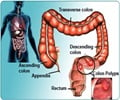
Ogino and colleagues used data from more than 100,000 women from the Nurses'' Health Study and more than 45,000 men in the Health Professionals Study to examine whether there was an association between body mass index (BMI) or exercise activity and colorectal cancer risk according to CTNNB1 expression status.
Among the study population, 2,263 individuals were diagnosed with colorectal cancer during follow-up. Tumor CTNNB1 expression data were available for 861 of these individuals, and 54 percent of these tumors were negative for CTNNB1 and 46 percent positive for the biomarker.
Increasing BMI by a 5.0 kg/m2 increment was associated with a 34 percent higher risk for CTNNB1-negative cancer, but was not associated with CTNNB1-positive cancer. In contrast, increasing physical activity level was associated with a significantly lower risk for CTNNB1-negative cancer. It was not associated with CTNNB1-positive cancer.
"Our results provide additional evidence for a causal role of obesity and a physically inactive lifestyle in a specific molecular subtype of colorectal cancer," Ogino said. "If physicians are able to identify individuals who are prone to develop CTNNB1-negative cancer, then it would be possible to strongly recommend physical activity."
In addition, the data indicated that CTNNB1 could be a potential target for chemoprevention and treatment, according to Ogino. He called for more population-based, large-scale databases to facilitate molecular pathological epidemiology research.
Advertisement
Source-Newswise














